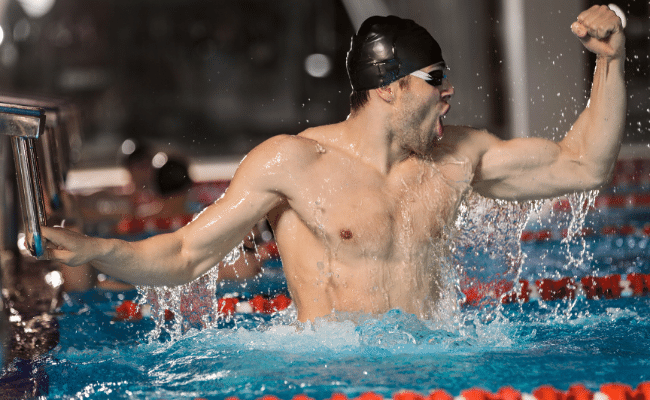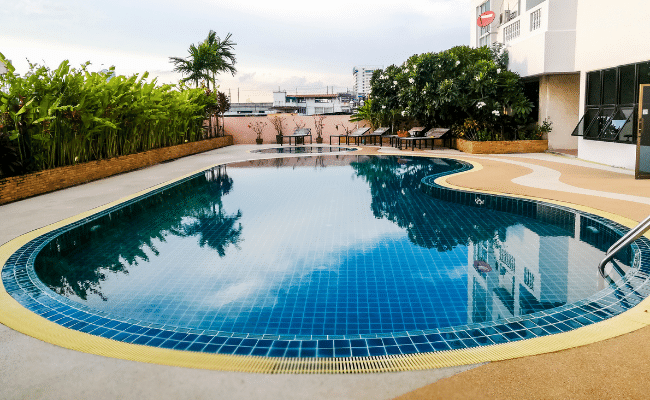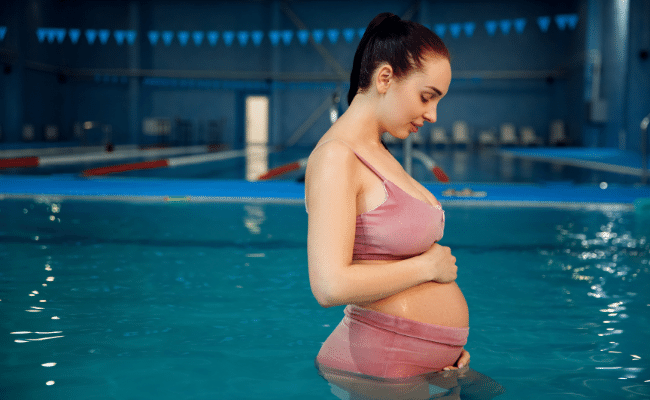
Table of Contents
Does Swimming Build Muscle? Swimming is a highly effective full-body workout that can help you build muscle when performed consistently and with proper technique. While it may not be as renowned for muscle building as weightlifting or resistance training, swimming engages a wide range of muscles throughout your body, making it an excellent choice for both cardiovascular fitness and muscle development.
Muscles Worked During Swimming
Swimming recruits various muscle groups, providing a comprehensive workout for your entire body. Here’s a breakdown of the major muscle groups involved in swimming:
1. Upper Body Muscles:
-
- Latissimus Dorsi (Lats): These large back muscles are heavily engaged during the pulling phase of each stroke, helping to propel you through the water.
- Deltoids (Shoulders): Your shoulders play a crucial role in moving your arms through the water, especially during the freestyle and butterfly strokes.
- Trapezius and Rhomboids: These muscles, located in your upper back, help stabilize your shoulder blades and provide support during each stroke.
2. Core Muscles:
-
- Abdominals (Rectus Abdominis and Obliques): Swimming demands a stable core to maintain proper body position and streamline. Engaging your core helps you swim efficiently and reduces drag in the water.
- Lower Back (Erector Spinae): These muscles work to keep your spine aligned and provide stability as you move your arms and legs.
3. Lower Body Muscles:
-
- Quadriceps: Located in the front of your thighs, the quadriceps help to kick and stabilize your legs as you swim.
- Hamstrings: The hamstrings at the back of your thighs are used during the kicking portion of most swim strokes.
- Glutes (Gluteus Maximus): Your buttocks muscles provide propulsion during the kicking phase, especially in strokes like freestyle and backstroke.
- Calves (Gastrocnemius and Soleus): These muscles are heavily engaged when you kick, contributing to your forward motion.
4. Arm Muscles:
-
- Biceps and Triceps: Both the pulling (propulsive) and recovery (return) phases of your arm strokes work your biceps and triceps. These muscles are responsible for generating power and maintaining arm movement.
- Forearms: The muscles in your forearms, such as the flexors and extensors, help control the position and movement of your hands in the water.
5. Neck Muscles:
-
- Neck muscles: The muscles in your neck are used to keep your head in a streamlined position and play a role in breathing while swimming.

6. Chest Muscles:
-
- Pectoral Muscles (Pecs): These muscles are engaged during the arm-pulling phase in strokes like breaststroke and butterfly. They contribute to the forward motion of your upper body.
7. Respiratory Muscles:
-
- Intercostal Muscles and Diaphragm: These muscles are vital for breathing while swimming. Efficient breathing is essential for endurance and overall performance.
8. Hip Flexors:
In strokes like freestyle and backstroke, the hip flexors are involved in kicking and maintaining a streamlined body position.
9. Adductors:
These muscles on the inner thighs help to stabilize your legs and maintain proper body alignment.
10. Ankle Flexors:
The muscles around your ankles are used during the flutter kick to generate propulsion.
The Muscle-Building Benefits of Swimming
Now that we’ve established which muscles are worked during swimming, let’s explore the muscle-building benefits of this activity:
- Full-Body Workout: Swimming engages multiple muscle groups simultaneously, making it a highly efficient full-body workout. This comprehensive engagement promotes overall muscle development.
- Resistance Training: Water offers natural resistance, requiring your muscles to work harder to overcome it. The resistance encountered during swimming can help increase muscle strength and endurance over time.
- Low Impact: Swimming is a low-impact exercise, which means it is gentle on your joints compared to high-impact activities like running. This allows individuals of all ages and fitness levels to engage in muscle-building workouts without excessive stress on the joints.
- Cardiovascular Benefits: While primarily a muscle-building exercise, swimming also provides excellent cardiovascular benefits. It improves your heart and lung health, which can enhance your overall fitness and stamina.
- Increased Muscle Definition: Swimming can help sculpt and define muscles, especially in the upper body, core, and legs. Regular swimming can lead to a toned and lean physique.
- Improved Posture: Strengthening the muscles of your back and core during swimming can contribute to better posture both in and out of the water.
- Weight Management: Swimming burns calories, making it a valuable component of a weight management or weight loss program. As you shed excess fat, your newly defined muscles become more visible.
- Cross-Training: Many athletes use swimming as a cross-training activity to complement their primary sports, as it offers a different form of conditioning that can enhance overall performance.
Tips for Maximizing Muscle-Building in Swimming
If you’re looking to maximize muscle-building during your swimming workouts, consider the following tips:
- Swim Regularly: Consistency is key to building muscle. Aim to swim regularly, whether it’s a few times a week or more, to see significant improvements.
- Vary Your Strokes: Different swim strokes engage different muscle groups. Mixing up your strokes can help ensure a balanced muscle development across your entire body.
- Incorporate Intervals: To increase the intensity of your swim and promote muscle growth, include interval training. Swim at a high intensity for short bursts, followed by periods of rest or lower-intensity swimming.
- Use Equipment: Incorporate swim equipment like paddles, fins, and kickboards to add resistance and vary your workout. These tools can help target specific muscle groups more intensely.
- Focus on Technique: Proper swimming technique is essential to optimize muscle engagement and prevent injury. Consider working with a swim coach or taking lessons to refine your form.
- Combine Swimming with Strength Training: To complement your swimming routine, consider incorporating strength training exercises on dry land. Targeting specific muscle groups with weights or bodyweight exercises can enhance your swimming performance and muscle-building results.
- Stay Hydrated and Eat Well: Proper nutrition and hydration are essential for muscle growth. Ensure you’re fueling your body with the right nutrients and staying hydrated before and after your swim sessions.
- Rest and Recovery: Adequate rest and recovery are crucial for muscle development. Allow your muscles time to recover between intense swim sessions to avoid overtraining.
Conclusion
Swimming is indeed an effective way to build muscle. It engages a wide range of muscle groups in your upper body, lower body, core, and even your respiratory muscles. Regular swimming, combined with proper technique, consistency, and attention to intensity, can lead to increased muscle strength, endurance, and definition. Whether you’re looking for a low-impact workout or a cross-training option to complement your fitness routine, swimming can be a valuable addition to your muscle-building journey.







